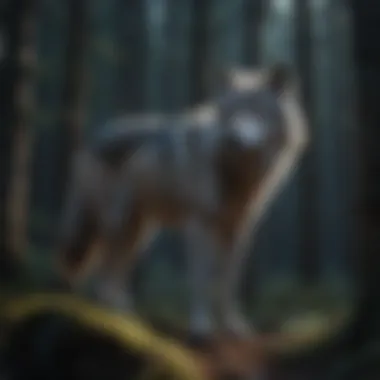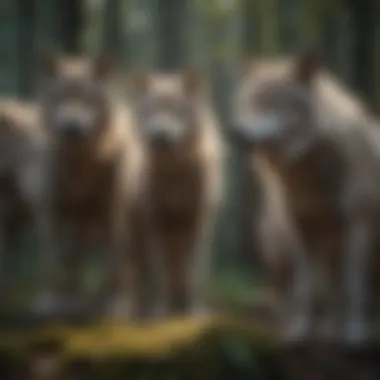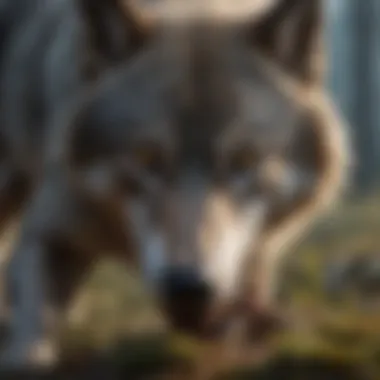Unveiling the Enigmatic World of Wolves: Behaviors, Habitats, and Conservation


Nature Theme Overview
This section delves deep into the fascinating world of wolves, showcasing their behavior, habitat, diet, and conservation status. Wolves are magnificent creatures with complex social structures and intriguing hunting strategies. Understanding these aspects provides a profound insight into the essence of these majestic animals.
Wildlife Encounters
In this segment, we explore the diverse species related to wolves. From Arctic wolves with their thick, white fur adapted to frigid climates, to red wolves found in the southeastern United States, each species presents unique adaptations for survival. Delving into the characteristics and habitats of these species offers a rich tapestry of the wolf family's diversity.
Fun Facts and Trivia
Unraveling the mysteries of wolves unveils intriguing facts that captivate young readers. Did you know that wolves communicate through howls that can be heard up to 10 miles away? Engaging visuals and interactive elements enrich the learning experience, making wildlife exploration both educational and enjoyable.
Environmental Consciousness
The importance of conservation and sustainability for wolves forms a crucial part of their survival. Children play a vital role in protecting wildlife, and understanding how to aid in conservation efforts can inspire a new generation of environmental stewards. Simple tips empower young minds to contribute positively to wolf preservation.
Nature Crafting and Activities
Encouraging hands-on activities and experiments at home creates a deeper connection to nature for children. From creating wolf masks to going on outdoor expeditions to observe wildlife firsthand, these engaging pursuits ignite curiosity and a sense of wonder. Step-by-step guides and suggestions for nature-inspired projects enrich the learning experience, fostering a love for wolves and the environment.
Introduction to Wolves
In this segment, we embark on a profound journey into the enigmatic realm of wolves. These remarkable creatures have long captivated the human imagination with their mystery and grace. The significance of this introductory section lies in laying the foundation for understanding the multifaceted aspects of wolf life - from their evolutionary history to their behavioral intricacies. By delving into the origins of wolves, their physical attributes, and behavioral traits, readers are poised to gain a profound appreciation for the majestic nature of these animals.
Evolution of Wolves
Origins of wolves
One of the most captivating aspects of studying wolves is tracing their origins back through time. Exploring the ancient roots of these creatures not only provides insight into their genetic makeup but also sheds light on their survival strategies. The story of how modern-day wolves descended from their ancestors is a testament to the resilience and adaptability of the species. Through understanding the origins of wolves, we can better appreciate their place in the diverse tapestry of the natural world.
Development of wolf species
The evolution of wolf species is a testament to the intricate dance of adaptation and natural selection. From the vast tundras of the Arctic to the dense forests of North America, different wolf species have emerged to thrive in diverse ecosystems. Their development over millennia showcases the genius of evolution in sculpting creatures perfectly suited to their environments. By examining the intricate pathways of wolf species' evolution, we unravel the secrets of their success in the wild.
Genetic adaptations
Genetic adaptations lie at the core of wolves' evolutionary journey. These remarkable creatures have fine-tuned their genetic makeup over generations to become formidable predators. From their keen sense of smell to their powerful jaws, every genetic adaptation in wolves serves a crucial purpose in their survival. Understanding these genetic nuances not only illuminates the practicality of nature's design but also deepens our admiration for the intricacies of wolf biology.
Physical Characteristics
As we transition into exploring the physical characteristics of wolves, we enter a realm of awe-inspiring details. From their size and weight to the nuances of their coat color and texture, each aspect contributes to the overarching magnificence of these creatures. Wolves possess a majestic presence in the wild, their physical attributes finely honed for survival in various environments.
Size and weight


The size and weight of wolves are crucial aspects of their biology. These creatures exhibit a range of sizes across different subspecies, reflecting variations in their habitat and diet. From the towering Arctic wolf to the sleek Ethiopian wolf, each size variation speaks to the evolutionary pressures faced by these animals. Exploring the intricate balance between size and agility unveils a world where every pound matters in the survival game of the wild.
Coat color and texture
The coat color and texture of wolves offer a visual feast for the eyes. From the snowy white coats of Arctic wolves to the earthy tones of Timber wolves, each hue serves a specific purpose in camouflaging these predators in their environment. The textures of wolf fur, ranging from dense winter coats to sleek summer layers, showcase their adaptability to seasonal changes. By unraveling the secrets of their coats, we gain a deeper appreciation for the artistry of nature's design.
Distinctive features
Within the tapestry of physical characteristics lies a myriad of distinctive features that set wolves apart from other predators. Their piercing eyes, sharp teeth, and powerful limbs embody the essence of a true apex predator. Each feature has been finely tuned by evolution to equip wolves for their vital roles in the ecosystems they inhabit. Venturing into the world of these distinctive features unfolds a saga of survival, adaptation, and unparalleled beauty.
Behavioral Traits
The behavioral traits of wolves offer a window into the intricate social structures and survival strategies of these remarkable creatures. From their pack dynamics to their sophisticated hunting strategies and communication methods, every behavior reflects the finely tuned instincts that have allowed wolves to thrive in the wild.
Pack dynamics
At the heart of wolf behavior lies the intricate dynamics of their packs. These tightly knit family units operate with remarkable efficiency, ensuring the survival and success of each member. The hierarchical structure of wolf packs, led by an alpha pair, showcases the intricate balance of power and cooperation within the group. Understanding the complexities of pack dynamics unveils a world where unity and strength walk hand in hand in the relentless pursuit of survival.
Hunting strategies
Wolves are renowned for their stealth and skill in hunting. Their hunting strategies, from coordinated pack hunts to individual pursuits, reflect a deep understanding of their prey and environment. The synchronized efforts of a wolf pack in bringing down large prey highlight their intelligence and adaptability. Exploring the nuances of their hunting strategies unveils a world where strategy, teamwork, and instinct converge to ensure the success of the pack.
Communication methods
Communication lies at the heart of wolf society, shaping every interaction within the pack. From howls that echo through the night to subtle body language cues, wolves employ a diverse array of communication methods to convey messages and maintain social order. The intricacies of their vocalizations and behaviors offer a window into the rich tapestry of wolf culture. Delving into their communication methods reveals a world where every howl, growl, and gesture carries significance in the intricate dance of pack life.
Habitat and Range
In our expedition through the enthralling realm of wolves, delving into their habitat and range unveils crucial insights into their survival and adaptation strategies. Where wolves dwell plays an imperative role in shaping their behavior and interactions with the ecosystem. Understanding the diverse natural habitats wolves inhabit - from the rugged forest ecosystems to the icy tundra regions and the expansive grasslands and savannas - offers an in-depth comprehension of their ecological significance. Each habitat type presents unique challenges and advantages, influencing the wolf population dynamics and prey availability.
Natural Habitats
Forest ecosystems
The intertwining canopies and rich biodiversity of forest ecosystems provide wolves with optimal coverage and resources for their survival. Wolves established in forest environments benefit from ample prey sources, dense foliage for camouflage, and intricate communication networks. However, the dense vegetation also poses challenges in hunting and visibility, shaping the wolves' hunting strategies and social organization.
Tundra regions
The stark beauty of tundra regions offers wolves a contrasting landscape characterized by vast open spaces and extreme weather conditions. Wolves adept in tundra settings navigate harsh winters and sparse vegetation, showcasing their resilience and adaptability. The scarcity of resources in tundra regions influences wolf pack dynamics, emphasizing cooperation and efficient hunting techniques to secure sustenance.
Grasslands and savannas
The sweeping vistas of grasslands and savannas form a picturesque backdrop for wolves to roam and thrive. Wolves roaming across these open habitats capitalize on their speed and agility, utilizing the expansive terrain for efficient hunting and territorial defense. The open grasslands foster a different hunting dynamic, where strategic planning and coordinated pack efforts are essential for successful predation.
Global Distribution


The worldwide distribution of wolves showcases their remarkable ability to adapt to diverse environments and challenges. From the continental distribution patterns to their adaptations across varied landscapes, wolves display a formidable resilience to environmental changes. Understanding the nuances of continental distribution, adaptation strategies, and range restrictions provides valuable insights into the global significance of wolf populations. Despite facing habitat loss, livestock depredation, and conservation challenges due to human-wolf conflicts, wolves persist in their quest for survival and ecological balance.
Diet and Feeding Behavior
Exploring the intriguing world of wolves involves a deep dive into their dietary habits and feeding behaviors. Wolves, as carnivorous predators, exhibit fascinating traits in obtaining their nutrition. This section sheds light on the critical role of diet and feeding behavior within the realm of wolf studies, offering a comprehensive understanding of their survival strategies and ecological impact.
Carnivorous Diet
Primary Prey Species
Wolves primarily target prey species rich in protein and essential nutrients for their carnivorous needs. In the wild, their primary prey includes deer, elk, moose, and smaller animals like rabbits. These species contribute significantly to the wolves' sustenance and overall survival. The adaptability of wolves in targeting varied prey exemplifies their efficient hunting skills and predatory behavior. By preying on these species, wolves maintain a delicate balance in the ecosystem, showcasing their strategic selection and hunting prowess.
Hunting Techniques
One of the prominent features of wolves is their diverse hunting techniques. From cooperative pack hunting to solitary stalking, wolves employ a range of strategies to secure their meals. Their collaborative approach in hunting large prey showcases their social intelligence and teamwork. Additionally, the utilization of ambush tactics and swift movements exemplifies their agility and precision in capturing prey. These hunting techniques not only ensure the wolves' survival but also reflect their evolutionary adaptations and predatory instincts.
Feeding Habits
Wolves exhibit distinctive feeding habits that contribute to their overall dietary patterns. After a successful hunt, wolves display intricate feeding rituals within their pack dynamics. These habits involve hierarchical feeding sequences, with dominant individuals consuming first, followed by the rest of the pack. Such feeding behaviors reflect social hierarchies and cooperation among pack members. Furthermore, wolves demonstrate efficient feeding habits by consuming different parts of their prey, ensuring minimal waste and maximal nutrient intake. These feeding habits not only sustain the wolves but also play a vital role in ecosystem balance and resource utilization.
Role in Ecosystem
Impact on Prey Populations
The wolves' presence in an ecosystem significantly influences prey populations. By regulating herbivore numbers through predation, wolves help control overgrazing and maintain the health of plant communities. This impact on prey populations reflects the wolves' ecological role as apex predators, shaping biodiversity and ecosystem dynamics. Additionally, the wolves' hunting patterns contribute to promoting genetic diversity within prey species, enhancing their resilience to environmental challenges.
Ecological Significance
The ecological significance of wolves extends beyond their direct interactions with prey. As keystone species, wolves play a crucial role in shaping the structure and functioning of ecosystems. Their presence cascades across trophic levels, influencing not just prey populations but also vegetation, smaller predators, and even soil composition. The intricate web of ecological interactions driven by wolves underscores their significance in maintaining balanced and healthy ecosystems, highlighting their irreplaceable role in the natural world.
Trophi
An essential aspect of wolves' ecological impact lies in their trophic relationships within food chains. Wolves occupy a prominent position as top predators, regulating the flow of energy and nutrients within ecosystems. Their consumption of herbivores maintains a check on vegetation browse, preventing overconsumption and habitat degradation. Moreover, wolves act as ecosystem engineers, shaping landscapes through their foraging and hunting behaviors. The trophic influence of wolves transcends individual prey-predator relationships, creating ripple effects that reverberate through entire ecosystems.
Conservation Status
In the rivetting journey through the complexities of understanding wolves in their entirety, the conservation status emerges as a pivotal aspect demanding utmost attention and consideration. Conservation status acts as the compass guiding efforts towards ensuring the continued existence and well-being of these remarkable creatures. It serves as a barometer of the balance between human activities and nature's intricate ecosystems in which wolves play an essential role. Delving into the nuances of conservation status unveils a tapestry woven with threads of interconnectedness, responsibility, and foresight.
Threats to Survival
Habitat destruction
One of the most harrowing menaces faced by wolves is the relentless force of habitat destruction. This insidious process carves away at the very fabric of the environments crucial to sustaining wolf populations. The striking feature of habitat destruction lies in its relentless march, eroding the natural landscapes that once provided sanctuary to these noble animals. The process of habitat destruction, though convenient in the short term for some human endeavors, exacts a heavy toll on the delicate balance of ecosystems by severing vital connections and disrupting the harmonious coexistence of species within them.
Illegal poaching


Illegal poaching stands as a dark shadow looming over the survival of wolves. The distinct trait of illegal poaching lies in its clandestine nature, covertly preying on wolf populations for personal gain and nefarious motives. This detrimental practice undermines conservation efforts and destabilizes the fragile equilibrium required for wolves to thrive. The unique feature of illegal poaching is its stealthy operation that evades detection, leaving behind a trail of irreparable harm and shattered ecosystems in its wake.
Climate change effects
The ominous specter of climate change casts a long shadow over the future of wolves and their habitats. The defining characteristic of climate change effects is their indiscriminate impact on the intricate web of life that sustains wolf populations. This ubiquitous threat poses challenges beyond borders, disrupting finely tuned ecosystems and reshaping landscapes at an unprecedented pace. The unique feature of climate change effects is their far-reaching consequences, altering the very foundation on which wolves have adapted and evolved over millennia.
Protection Efforts
Legislative measures
Within the nexus of safeguarding wolves, legislative measures stand as pillars of support and guardians of their well-being. The key characteristic of legislative measures is their ability to enact policies that shield wolves from harm and preserve their habitats. This proactive stance ensures that legal frameworks act as bulwarks against threats, offering a shield against unbridled exploitation. The unique feature of legislative measures lies in their capacity to reflect societal values and uphold a collective commitment to safeguarding the intricate tapestry of nature that wolves are an integral part of.
Conservation initiatives
Amidst the challenges faced by wolves, conservation initiatives emerge as beacons of hope illuminating the path towards a sustainable coexistence. The defining feature of conservation initiatives is their proactive approach towards engaging communities in preserving wolf populations and their habitats. These initiatives mobilize resources and expertise to implement strategic actions that address root causes of endangerment. The unique feature of conservation initiatives lies in their capability to foster a shared sense of responsibility and cultivate harmonious relationships between wolves and their human counterparts.
Community involvement
At the heart of conservation efforts lies the invaluable role of community involvement, where individuals become stewards of wolf conservation. The key characteristic of community involvement is its power to forge meaningful connections between local populations and the plight of wolves. By mobilizing grassroots support and fostering environmental stewardship, community involvement creates a ripple effect of positive change that reverberates across landscapes. The unique feature of community involvement is its ability to bridge gaps, bringing diverse perspectives together in a unified front to safeguard the future of wolves and the ecosystems they call home.
Interaction with Humans
The aspect of interaction with humans in this article concerning wolves is of paramount importance. Understanding the nuanced relationship between humans and wolves sheds light on the coexistence and conflicts that may arise. This interaction delves into the cultural significance, scientific studies, and societal perceptions surrounding wolves. By exploring how humans perceive and interact with wolves, we can glean insights into conservation efforts, ecological research, and educational programs focused on preserving wolf populations. The multifaceted nature of human-wolf interaction adds a layer of complexity to the narrative of wolf conservation and environmental stewardship.
Cultural Significance
Native American folklore
Incorporating Native American folklore into discussions about wolves enriches the narrative with historical and symbolic depth. The storytelling tradition of Native American tribes offers a rich tapestry of myths, legends, and spiritual connections to wolves. The reverence and respect accorded to wolves in Native American folklore underscore their symbolic significance as spirit guides, symbols of loyalty, and embodiments of wild wisdom. By delving into these ancient narratives, we gain a profound understanding of the primal bond between indigenous peoples and wolves, encapsulating themes of harmony, survival, and interconnectedness with nature.
Mythological representations
Examining wolves through mythological representations reveals a universal fascination with these enigmatic creatures. Myths across different cultures depict wolves as mysterious beings embodying traits of cunning, loyalty, and freedom. The enduring appeal of wolf symbolism in mythology resonates with themes of transformation, guardianship, and primal instincts. By exploring these symbolic representations, we unravel the collective imagination's enduring fascination with wolves and their enduring place in the human psyche.
Symbolism in modern society
The symbolism of wolves in modern society reflects a duality of admiration and fear, shaped by centuries of folklore, literature, and popular culture. Wolves often symbolize independence, resilience, and the untamed spirit in contemporary contexts. However, negative portrayals in media and folklore have perpetuated misconceptions leading to fears and misconceptions about these apex predators. Unraveling the symbolism of modern society around wolves provides an opportunity to challenge stereotypes, foster conservation awareness, and promote coexistence between humans and these majestic animals.
Research and Education
Scientific studies on wolves
The scientific study of wolves offers invaluable insights into their behavior, ecology, and evolutionary history. Researchers employ techniques such as radio telemetry, DNA analysis, and behavioral observations to unravel the intricacies of wolf social structures, hunting dynamics, and adaptive strategies. These studies contribute to conservation efforts, informing management practices, and ecosystem preservation initiatives. By critically evaluating scientific findings, we can appreciate the ecological role of wolves and advocate for evidence-based conservation policies.
Educational programs
Educational programs focusing on wolves play a crucial role in raising awareness and dispelling myths surrounding these apex predators. Schools, wildlife centers, and conservation organizations utilize interactive learning tools, wildlife presentations, and field trips to engage students and the public in wolf conservation efforts. By fostering empathy and understanding through education, these programs empower future generations as stewards of wildlife and ecosystems. Encouraging active participation in conservation activities, these initiatives bridge the gap between scientific knowledge and public misconceptions about wolves.
Role in ecological research
The pivotal role of wolves in ecological research extends beyond species-specific studies to broader ecosystem dynamics and biodiversity conservation. By investigating the trophic cascades initiated by wolf predation, researchers uncover the intricate connections between predator-prey relationships, vegetation patterns, and ecosystem resilience. Wolves act as keystone species, maintaining the balance of fragile ecosystems and preserving biodiversity. Understanding the cascading effects of wolf reintroduction, behavior modification, and habitat restoration informs holistic conservation strategies aimed at restoring the ecological integrity of landscapes.







